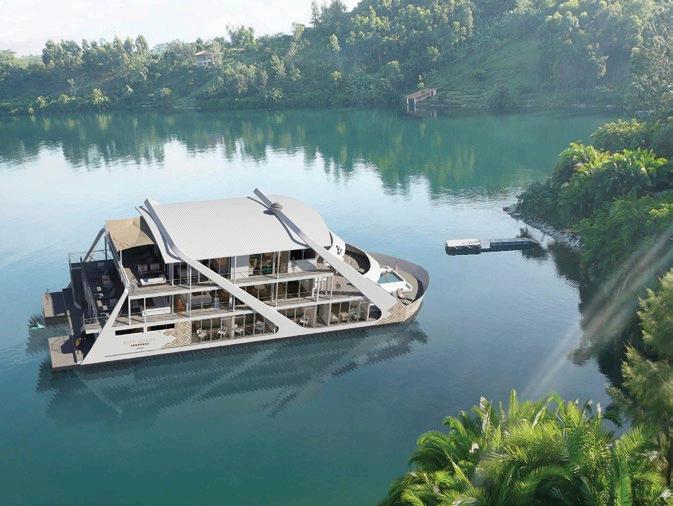
4 minute read
POSTCARD
RWANDA
Great lake luxury
Imagine exploring one of the most biodiverse ecozones of the world – the Albertine rift montane forest – from the comfort of a floating luxury hotel as it cruises one of Africa’s great lakes: Lake Kivu in Rwanda.
It will soon be possible, with the Mantis Kivu Queen uBuranga launching soon. Featuring 10 modern cabins, a swimming pool, restaurant, bar, wellness centre and a viewing deck with a hot tub, the onboard experience is tempting enough, but it’s the once-in-a-lifetime opportunity to discover this remote part of the world that is really special. Guests can take part in guided hikes, bird watching, meander through quaint Rwandan villages and get up-close-and-personal with the local wildlife, all the time enjoying the mild equatorial montane climate. In line with the Mantis Collection’s commitment to sustainability and conservation, the Kivu Queen adds value to the environment and communities of Lake Kivu and is staffed by a team of local people.
The intimate houseboat complements two recently opened properties in Rwanda, the Mantis Kivu Marina Bay Hotel, which offers guests unique cultural experiences such as tea and coffee tastings at some of the best plantations in Africa, and Mantis Akagera Game Lodge, the only Big Five Reserve in the country. This property stands on a hill elevated above the savannah, with outstanding views of Lake Ihema. Gemma Greenwood
Immigration as an investment model
Shai Zamanian, U.S. Licensed Lawyer and Migration Specialist at The American Legal Centre, based in Dubai, explains how to maximise the benefits of citizenship by investment programmes
As capital markets continue to expand in places like China and India, while access to Western countries continue to become more restrictive, entrepreneurs from around the world are finding innovative ways to access residency or secondary passports. The model of exchanging residency rights for a sizable investment has fuelled the demand for governments to diversify their immigration programmes and to include these options. As the populairy of immigrant investor programmes has swelled, they have proved to be pertinent tools for the growth of various countries’ economies. While the main reason that prospective investors choose such routes is to have a guaranteed way to obtain a second passport or residency in developed countries and to further secure their multigenerational future, they must also be aware of the maximum potential in terms of the benefits these programmes deliver to the individual.
The benefits of these programmes are clear: an investor invests a specific amount of money and in return, they get residency rights in that particular country.
While the specifics of each programme will differ as per the country that offers it, the general idea is that money is invested into the country’s economy and residency rights are passed on to the deserving party. Now, the question is, can these investors use these programmes as a dual benefit model where on the completion of their application they end up with investment and residency rights for themselves and dependants?
The answer is yes, as long as the investor chooses a country that uses the investment in a private-sector asset model and selects the right project to invest in. The private-sector investment model requires the investor to invest their money into an in-country asset (barring government bonds).
After the completion of the investment cycle the investor can reclaim their money provided their investment was a success. While the investment is in its investment cycle the petition for the residency rights will be in process and the two will be working simultaneously for the benefit of all parties concerned.
For instance, the United States EB-5 immigrant investment programme follows this model, but with the key factor that the investor has complete knowledge that his investment is a true investment. This means the investment made to a U.S. commercial enterprise is done so at the risk of the investor.
It must be noted that failure of an investment will not necessarily result in the denial of the immigration petition, provided the failure of the investment is not due to the investor choosing a project that does not meet the United States Citizenship and Immigration Services requirements.
To increase the chances of a successful investment the investor must ensure they do their diligence. Prior to making the investment, the investor must check the capital structure of the project, the chances of its success, the number of jobs created, and whether the appropriate certifications are in place to qualify for the minimum $900,000 investment threshold.
Choosing the right investment project can provide the investor with a rate of return on investment post the investment cycle and in many cases they will receive their investment funds back after a specific period.
Individuals signing up to this model will need to consult with experienced immigration consultants along with independent financial advisors prior to making any decision.
The American Legal Centre, based in Downtown Dubai, has a large focus and experience on the EB-5 immigrant investor programme. It has assisted families in the GCC and emerging markets to gain U.S. green cards in the region and as such, obtained more than 500 green cards.










